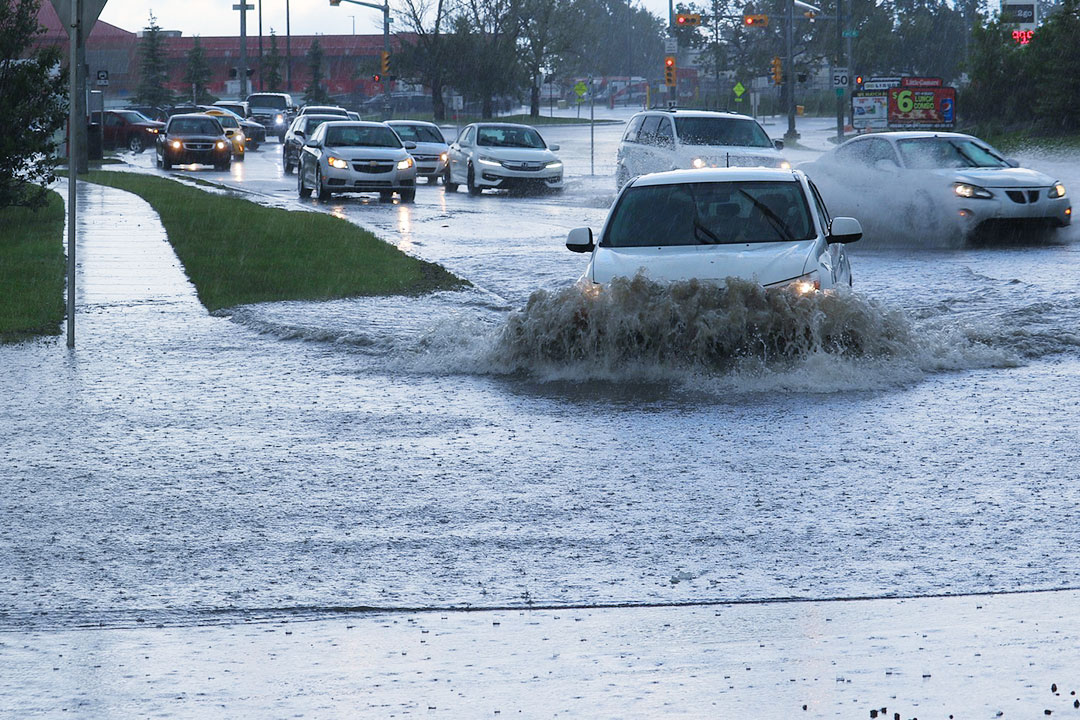Flash Flood Emergency: Causes, Effects, And Safety Measures

Table of Contents
Causes of Flash Floods
Flash floods are typically caused by a combination of factors, often involving intense rainfall overwhelming the natural and artificial drainage systems of an area.
Intense Rainfall
Short-duration, high-intensity rainfall is the primary cause of most flash floods. When the rate of rainfall exceeds the ground's capacity to absorb it, water rapidly accumulates, leading to surface runoff. This is exacerbated by already saturated ground from prior rainfall or snowmelt, and inadequate drainage systems in urban or developed areas. Meteorological phenomena such as severe thunderstorms, hurricanes, and monsoons can produce the type of torrential rainfall that triggers flash floods.
- Sudden downpours exceeding the ground's absorption capacity.
- Convective storms producing large amounts of rain in a short period.
- Failure of drainage infrastructure to cope with intense rainfall, leading to rapid water accumulation.
Dam Failures and Levee Breaches
The catastrophic failure of dams or levees can unleash massive volumes of water downstream, causing devastating flash floods. These structures, designed to control water flow and prevent flooding, can fail due to structural weaknesses, overloading from excessive rainfall, or erosion undermining their foundations. Historical examples of dam failures illustrate the widespread and rapid flooding that can result, underscoring the importance of regular dam maintenance and inspection.
- Structural weaknesses in dams or levees due to age, poor construction, or lack of maintenance.
- Overflowing dams due to excessive rainfall exceeding their designed capacity.
- Erosion undermining dam foundations, leading to sudden and catastrophic collapse.
Upstream Flooding
Flooding in upstream areas can quickly translate into flash floods downstream. Rapid water release from upstream reservoirs, the sudden melting of snow or ice in mountainous regions, or upstream dam failures can all contribute to a sudden and significant increase in water volume downstream, resulting in flash floods in lower-lying areas. Monitoring upstream water levels is crucial for predicting and mitigating the risk of downstream flash floods.
- Rapid water release from upstream reservoirs due to dam operation or uncontrolled releases.
- Sudden melting of snow or ice in mountainous regions, particularly during rapid warming events.
- Upstream dam failures contributing to a surge of water downstream, creating a flash flood emergency.
Effects of Flash Floods
Flash floods have devastating and far-reaching effects, impacting lives, property, and the environment.
Loss of Life and Injuries
The most significant impact of flash floods is the loss of life and injuries. Drowning is the leading cause of death, as rapidly rising waters can overwhelm individuals before they can escape. Fast-moving water carries debris, causing traumatic injuries from impact. The psychological impact of experiencing a flash flood can also be significant, leading to long-term mental health consequences.
- Drowning as the leading cause of death during flash floods.
- Traumatic injuries from impact with debris carried by fast-moving water.
- Mental health consequences, including PTSD and anxiety, resulting from flood-related trauma.
Property Damage and Economic Losses
Flash floods cause extensive damage to homes, businesses, and infrastructure. The cost of repairing or replacing damaged buildings, roads, bridges, and other infrastructure can be immense. The disruption of economic activity resulting from business closures, damaged supply chains, and loss of productivity leads to significant financial losses for individuals, businesses, and communities.
- Destruction of homes and businesses due to floodwaters, leading to displacement and financial hardship.
- Damage to roads, bridges, and other vital infrastructure, disrupting transportation and access to essential services.
- Disruption of economic activity, resulting in lost productivity, business closures, and significant financial losses.
Environmental Impact
Flash floods significantly impact ecosystems and wildlife. The force of the water can cause habitat destruction and loss of biodiversity. Floodwaters often become contaminated with sewage, industrial waste, and agricultural chemicals, polluting water sources and harming aquatic life. Soil erosion from the floodwaters can also damage agricultural land, reducing its productivity.
- Habitat destruction and loss of biodiversity due to the force of the floodwaters.
- Water contamination from sewage, industrial waste, and agricultural chemicals, posing risks to human and environmental health.
- Soil erosion and damage to agricultural land, reducing crop yields and impacting food security.
Safety Measures During a Flash Flood Emergency
Being prepared and knowing how to react during a flash flood emergency is crucial for survival.
Preparedness and Evacuation
Having a family emergency plan is essential. Identify high-risk areas prone to flash floods and plan evacuation routes to higher ground. Establish a communication plan with family members and know the location of designated shelters. Monitor weather forecasts and heed official warnings, taking action immediately if a flash flood warning is issued.
- Develop a communication plan for family members, including designated meeting points and contact information.
- Identify evacuation routes and safe meeting points in advance, considering multiple escape paths.
- Monitor weather forecasts and heed official warnings from local authorities, acting swiftly on any advisories.
Staying Safe During a Flash Flood
Never attempt to drive or walk through floodwaters; even shallow water can be deceptively dangerous. If a flash flood warning is issued, move to higher ground immediately. Avoid contact with downed power lines or electrical equipment. Listen to emergency broadcasts for updates and instructions.
- Never attempt to drive or walk through floodwaters, as even seemingly shallow water can sweep a person away.
- Move to higher ground immediately if a flash flood warning is issued.
- Avoid contact with downed power lines or electrical equipment, as these pose a significant electrocution risk.
Post-Flood Safety
After a flash flood, avoid contact with floodwaters, as they are likely contaminated with sewage, chemicals, and debris. Thoroughly clean and disinfect affected areas to prevent the spread of disease. Consult with professionals to assess structural damage before re-entering buildings.
- Avoid contact with floodwaters due to potential contamination with sewage, chemicals, and other hazardous materials.
- Thoroughly clean and disinfect affected areas to prevent the spread of waterborne diseases.
- Consult with structural engineers or other qualified professionals to assess damage before re-entering buildings.
Conclusion
Flash floods are a serious threat, causing significant loss of life, property damage, and environmental disruption. Understanding the causes, potential effects, and implementing appropriate safety measures are crucial for mitigating risks. By preparing in advance, heeding warnings, and taking immediate action when a flash flood is imminent, you significantly increase your chances of survival and minimize potential damage. Remember, staying informed and prepared is your best defense against a flash flood emergency. Learn more about flash flood safety in your area and create a personalized plan to protect yourself and your loved ones from flash flood dangers.

Featured Posts
-
 Photo Of Kidnapped Idf Soldier Matan Angrest Shows Visible Wounds
May 26, 2025
Photo Of Kidnapped Idf Soldier Matan Angrest Shows Visible Wounds
May 26, 2025 -
 Leclerc Fastest In Monaco Gp Fp 1 Verstappens Hot Pursuit
May 26, 2025
Leclerc Fastest In Monaco Gp Fp 1 Verstappens Hot Pursuit
May 26, 2025 -
 Apples Ceo Tim Cook Faces Mounting Headwinds
May 26, 2025
Apples Ceo Tim Cook Faces Mounting Headwinds
May 26, 2025 -
 47 Y Mmkf Gde I Kogda Uznat Imena Pobediteley V Moskve
May 26, 2025
47 Y Mmkf Gde I Kogda Uznat Imena Pobediteley V Moskve
May 26, 2025 -
 Nike Running Shoes 2025 Top Models For Performance And Style
May 26, 2025
Nike Running Shoes 2025 Top Models For Performance And Style
May 26, 2025
Latest Posts
-
 New Last Friday Movie In The Works Ice Cube To Write And Star
May 27, 2025
New Last Friday Movie In The Works Ice Cube To Write And Star
May 27, 2025 -
 New Last Friday Movie In The Works With Ice Cube
May 27, 2025
New Last Friday Movie In The Works With Ice Cube
May 27, 2025 -
 Last Friday Sequel Confirmed Ice Cube Reportedly Attached
May 27, 2025
Last Friday Sequel Confirmed Ice Cube Reportedly Attached
May 27, 2025 -
 Ice Cube Officially Set For New Friday Film
May 27, 2025
Ice Cube Officially Set For New Friday Film
May 27, 2025 -
 Last Friday Sequel Confirmed Ice Cube To Star And Write
May 27, 2025
Last Friday Sequel Confirmed Ice Cube To Star And Write
May 27, 2025
